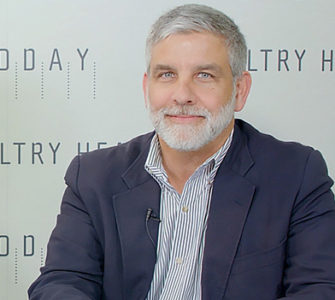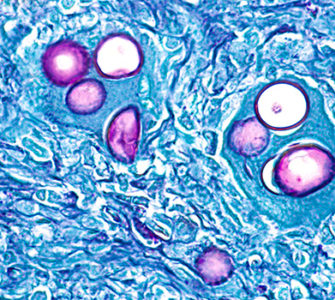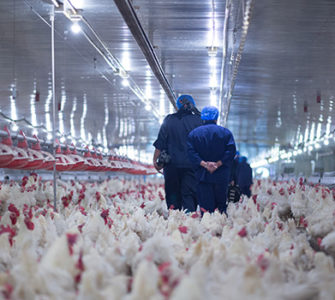Coccidiosis: An old problem with some new challenges
Coccidiosis in broiler houses remains a nagging challenge. While clinical manifestations are rare, it’s the subclinical condition that impacts the flock through poor feed efficiency and reduced growth rates. Not only does that weigh on a farms’ productivity and profitability, but also the birds’ well-being.
“It’s the same old problem and it’s a moving target at the same time. It’s the same species coming at you in different ways, different seasons,” Phil Stayer, DVM at Sanderson Farms, told Poultry Health Today. “The tools have changed through the years; we’ve lost some good tools and gained some others. It’s a constant battle against this organism, and it’s been that way for 30 years.”
What’s important is to have a strategy, be flexible and willing to test treatments to find what works best and what may need to change.
Surveying flock health
One step in Sanderson Farms’ strategy to address coccidiosis is to take a sampling of broilers every 6 to 8 weeks. “We call them health surveys,” Stayer said, “because we look at everything in the bird, but primarily for coccidiosis.”
Farm personnel select a small sample of “normal-looking birds” to necropsy, looking for signs of subclinical disease before birds reach market weight. Combining this information with feed efficiency and growth rate data can signal intestinal damage underway. “Small movements in those numbers will tell us more or less how the birds are doing,” he added.
Because most of the damage is done to the birds before clinical symptoms surface, it’s important to get an early start, and for Sanderson Farms that involves using vaccination followed by an in-feed anticoccidial. Over the years, they’ve tried separating those two treatments, but bird performance suffered.
Notably, wintertime can present some extra management challenges for coccidiosis control, but Stayer relayed that for the past two seasons, Sanderson Farms has adopted a year-round program of vaccines and in-feed control. “That seems to be working well for us,” he added.
Vaccine coverage is key
Coccidiosis vaccines can be administered in ovo or day-of-age. Sanderson Farms has taken both routes over the years and has settled on day-of-age, Stayer said.
Ensuring uniform vaccine coverage across all chicks remains a challenge. “I wish I had the answer,” he added. “Current technology is definitely limited and you do the best you can with what you have.”
While there are different vaccine application methods, the actual spray mechanisms don’t differ significantly. Rather, it’s the cabinets that can influence the coverage, Stayer pointed out. “They’re all different and the easier they are to use and clean, the more likely the vaccination will be done right.”
His other tip for thorough vaccination is “having supplier accountability.” By this he means requiring vaccine manufacturer representatives visit hatcheries regularly to ensure that administration is being done correctly.
“The lower the vaccine uptake the more clinical problems you would have later in that flock,” Stayer noted. “So, the best coverage involves making sure the machines work, the mix is right, the storage is right, and doing everything as well as you can.”
Management matters
Along with vaccines, a critical part of immune support is bird husbandry. “First thing, is taking care of animal well-being,” Stayer said, “providing the best environment possible – temperatures, air quality – and water and feed availability.”
Part of the broiler management consideration is whether or not to use in-feed anticoccidials or ionophores, of which Sanderson Farms has used both over the years.
Stayer emphasized that anytime you change treatments, patience is important. “When moving from one program to another, the first couple of weeks may not indicate how well the program will eventually work.”
Although Ionophores are slow to develop resistance, in time a tolerance will develop in the coccidia species in the broiler house. “There’s some thought that adding vaccines may help keep the ionophores persistent as well,” Stayer said. “So, rotating ionophores may not be as important now as it used to be if we’re using a vial-shuttle vaccine with ionophores.”
Still, he noted that rotating ionophores may be a wise long-term strategy. “Maybe not every year, but over years,” he added. “Each ionophore has its strengths and weaknesses, and if you’ve not used a particular ionophore, it should show its strengths better when you go back to it.”
Of course, to say that result will occur every time at every location, is a misconception. Stayer noted that he’s witnessed geographical differences in ionophores’ response to coccidiosis challenges. To maintain product efficiency, he advised watching the birds. “They will tell you. You also can compare one ionophore to another, side by side. How they worked in your environment, with the particular [coccidia] isolates that you have.”
Considering future developments to better control coccidiosis, Stayer doesn’t see many changes on the horizon. “Getting the vaccine into every bird is the limitation of the current technology. To spray a box of 100 birds, we know not everyone gets an even dose,” he said. “If we get every bird a uniform dose, we’d be ahead of the game. So, that’s the next technological step.”
Posted on December 1, 2022

















